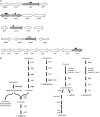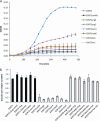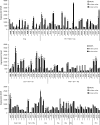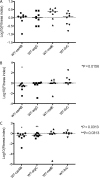Identification of genes important for growth of asymptomatic bacteriuria Escherichia coli in urine
- PMID: 22753377
- PMCID: PMC3418751
- DOI: 10.1128/IAI.00473-12
Identification of genes important for growth of asymptomatic bacteriuria Escherichia coli in urine
Abstract
Escherichia coli is the most important etiological agent of urinary tract infections (UTIs). Unlike uropathogenic E. coli, which causes symptomatic infections, asymptomatic bacteriuria (ABU) E. coli strains typically lack essential virulence factors and colonize the bladder in the absence of symptoms. While ABU E. coli can persist in the bladder for long periods of time, little is known about the genetic determinants required for its growth and fitness in urine. To identify such genes, we have employed a transposon mutagenesis approach using the prototypic ABU E. coli strain 83972 and the clinical ABU E. coli strain VR89. Six genes involved in the biosynthesis of various amino acids and nucleobases were identified (carB, argE, argC, purA, metE, and ilvC), and site-specific mutants were subsequently constructed in E. coli 83972 and E. coli VR89 for each of these genes. In all cases, these mutants exhibited reduced growth rates and final cell densities in human urine. The growth defects could be complemented in trans as well as by supplementation with the appropriate amino acid or nucleobase. When assessed in vivo in a mouse model, E. coli 83972carAB and 83972argC showed a significantly reduced competitive advantage in the bladder and/or kidney during coinoculation experiments with the parent strain, whereas 83972metE and 83972ilvC did not. Taken together, our data have identified several biosynthesis pathways as new important fitness factors associated with the growth of ABU E. coli in human urine.
Figures






Similar articles
-
The asymptomatic bacteriuria Escherichia coli strain 83972 outcompetes uropathogenic E. coli strains in human urine.Infect Immun. 2006 Jan;74(1):615-24. doi: 10.1128/IAI.74.1.615-624.2006. Infect Immun. 2006. PMID: 16369018 Free PMC article.
-
Asymptomatic bacteriuria Escherichia coli strains: adhesins, growth and competition.FEMS Microbiol Lett. 2006 Sep;262(1):22-30. doi: 10.1111/j.1574-6968.2006.00355.x. FEMS Microbiol Lett. 2006. PMID: 16907735
-
Contribution of siderophore systems to growth and urinary tract colonization of asymptomatic bacteriuria Escherichia coli.Infect Immun. 2012 Jan;80(1):333-44. doi: 10.1128/IAI.05594-11. Epub 2011 Sep 19. Infect Immun. 2012. PMID: 21930757 Free PMC article.
-
Rapid Growth and Metabolism of Uropathogenic Escherichia coli in Relation to Urine Composition.Clin Microbiol Rev. 2019 Oct 16;33(1):e00101-19. doi: 10.1128/CMR.00101-19. Print 2019 Dec 18. Clin Microbiol Rev. 2019. PMID: 31619395 Free PMC article. Review.
-
Asymtomatic Bacteriuria as a Model to Study the Coevolution of Hosts and Bacteria.Pathogens. 2016 Feb 15;5(1):21. doi: 10.3390/pathogens5010021. Pathogens. 2016. PMID: 26891332 Free PMC article. Review.
Cited by
-
Discovery and Characterization of Human-Urine Utilization by Asymptomatic-Bacteriuria-Causing Streptococcus agalactiae.Infect Immun. 2015 Nov 9;84(1):307-19. doi: 10.1128/IAI.00938-15. Print 2016 Jan. Infect Immun. 2015. PMID: 26553467 Free PMC article.
-
Adaptation of Arginine Synthesis among Uropathogenic Branches of the Escherichia coli Phylogeny Reveals Adjustment to the Urinary Tract Habitat.mBio. 2020 Sep 29;11(5):e02318-20. doi: 10.1128/mBio.02318-20. mBio. 2020. PMID: 32994329 Free PMC article.
-
"Omics" Technologies - What Have They Told Us About Uropathogenic Escherichia coli Fitness and Virulence During Urinary Tract Infection?Front Cell Infect Microbiol. 2022 Feb 14;12:824039. doi: 10.3389/fcimb.2022.824039. eCollection 2022. Front Cell Infect Microbiol. 2022. PMID: 35237532 Free PMC article. Review.
-
Metabolomics survey of uropathogenic bacteria in human urine.Front Microbiol. 2024 Dec 18;15:1507561. doi: 10.3389/fmicb.2024.1507561. eCollection 2024. Front Microbiol. 2024. PMID: 39744398 Free PMC article.
-
Effect of Bladder Catheterization On Bacterial Interference With Asymptomatic Escherichia coli Strain 83972 in an Experimental Porcine Model of Urinary Tract Infection.J Infect Dis. 2025 Feb 20;231(2):e355-e363. doi: 10.1093/infdis/jiae404. J Infect Dis. 2025. PMID: 39163139 Free PMC article.
References
-
- Alteri CJ, Smith SN, Mobley HL. 2009. Fitness of Escherichia coli during urinary tract infection requires gluconeogenesis and the TCA cycle. PLoS Pathog. 5:e1000448 doi:10.1371/journal.ppat.1000448 - DOI - PMC - PubMed
-
- Darouiche RO, et al. 2001. Pilot trial of bacterial interference for preventing urinary tract infection. Urology 58:339–344 - PubMed
Publication types
MeSH terms
Substances
LinkOut - more resources
Full Text Sources
Other Literature Sources
Medical

